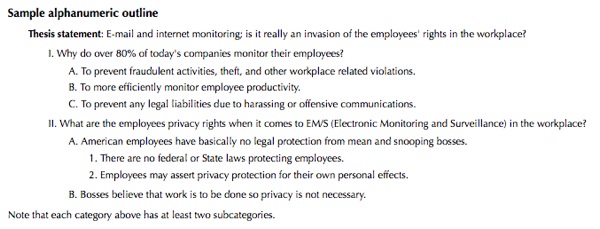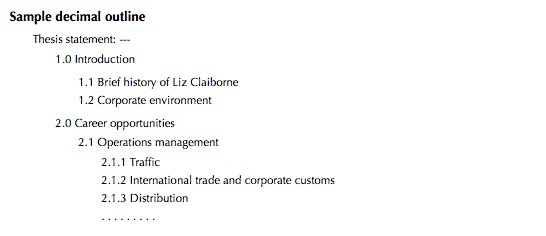Outline
An outline is a rough draft or summary of the main features of a given topic.[1] A hierarchical outline is an outline, often in list form, arranged to show hierarchical relationships.
Writers of fiction and creative nonfiction, such as Jon Franklin, may use outlines to establish plot sequence, character development and dramatic flow of a story, sometimes in conjunction with freewriting.
Merriam-Webster's manual for writers and editors (1998, p. 290) recommends that the section headings of an article should, when read in isolation, combine to form an outline of the article content. Garson (2002) distinguishes a 'standard outline', presented as a regular table of contents from a refined tree-like 'hierarchical outline', stating that "such an outline might be appropriate, for instance, when the purpose is taxonomic (placing observed phenomena into an exhaustive set of categories). ... hierarchical outlines are rare in quantitative writing, and the researcher is well advised to stick to the standard outline unless there are compelling reasons not to."[3]
Propædia is the historical attempt of the Encyclopædia Britannica of presenting a hierarchical "Outline of Knowledge" in a separate volume in the 15th edition of 1974. The "Outline of Knowledge" was a project by Adler Mortimer Adler. Propædia had three levels, 10 "Parts" at the top level, 41 "Divisions" at the middle level and 167 "Sections" at the bottom level, numbered, for example "1. Matter and Energy", "1.1 Atoms", "1.1.1. Structure and Properties of Atoms".
Hierarchical outlines
Alphanumeric outlines
An alphanumeric outline uses Roman numerals, capitalized letters, Arabic numerals, and lowercase letters, in that order. Each numeral or letter is followed by a period, and each item is capitalized:
Note that each category above has at least two subcategories.
Some call the Roman numerals above a-heads, the capitalized letters, b-heads, and so on. Some writers also prefer to insert a blank line between the a-heads and b-heads (N.B. these people keep the b-heads and c-heads together, though).
If more levels of outline are needed, lowercase roman numerals and numbers and lowercase letters with single and double parenthesis can be used, although the exact order is not well defined, and usage varies widely. The Chicago Manual of Style[4] suggests the sequence I. A. 1. a) (1) (a) i) (capital roman numerals with a period, capital letters with a period, numerals with a period, lowercase letters with a single parenthesis, numerals with a double parenthesis, lowercase letters with a double parenthesis, and lowercase roman numerals with a single parentheses) for the first seven levels. Another scheme uses I. A. 1. a. i. for the first five levels, then repeats those with a single parenthesis for the next five – I) A) 1) a) i) – and with a double parenthesis for the next five – (I) (A) (1) (a) (i). [edit] Decimal outlines
References
- Mary Ellen Guffey, "Organizing and Writing Business Messages," Business Communication: Process and Product, p. 160-161.
- "Numbers: Lists and Outlines," Manual for Writers and Editors (Merriam-Webster, Incorporated: 1998), p. 103.
- White, Basil (1996) Developing Products and Their Rhetoric from a Single Hierarchical Model, 1996 Proceedings of the Annual Conference of the Society for Technical Communication, 43, 223-224. [1]
- OWL: Online Writing Lab, Purdue University
- "Report writing," Britannica Student Encyclopedia, Encyclopædia Britannica Online (Accessed January 5, 2006)
- William E. Coles, Jr. "Outline," World Book Online (Accessed January 5, 2006)
- Ted Goranson's About this Particular Outliner 'Outlining and Styles'
- Jon Franklin "Writing for Story", Penguin 1994.
Notes
1. OED: " outline n.
- a. In pl. The main features or general principles of a subject, proposal, etc.
- b. A brief verbal or written description of something, giving a general idea of the whole but leaving details to be filled in; a rough draft, a summary. Also: a précis of a proposed article, novel, scenario, etc.
2. Writing for Story, Penguin, 1994 3. G. David Garson, Guide to writing empirical papers, theses, and dissertations CRC Press, 2002, ISBN 9780824706050, chapter "Typical Outlines", pp. 23-34. 4. The Chicago Manual of Style, 14th ed., The University of Chicago Press, 1993


